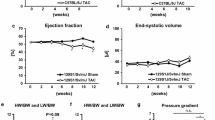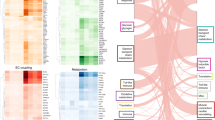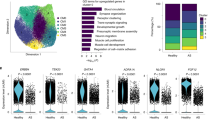Abstract
Hypertension and cardiomyopathies share maladaptive changes of cardiac morphology, eventually leading to heart failure. These include left ventricular hypertrophy (LVH), myocardial fibrosis, and structural remodeling of coronary microcirculation, which is the morphologic hallmark of coronary microvascular dysfunction. To pinpoint the complex molecular mechanisms and pathways underlying LVH-associated cardiac remodeling independent of blood pressure effects, we employed gene network approaches to the rat heart. We used the Spontaneously Hypertensive Rat model showing many features of human hypertensive cardiomyopathy, for which we collected histological and histomorphometric data of the heart and coronary vasculature, and genome-wide cardiac gene expression. Here, we provide a large catalogue of gene co-expression networks in the heart that are significantly associated with quantitative variation in LVH, microvascular remodeling, and fibrosis-related traits. Many of these networks were significantly conserved to human idiopathic and/or ischemic cardiomyopathy patients, suggesting a potential role for these co-expressed genes in human heart disease.





Similar content being viewed by others
References
Mancini, M., Petretto, E., Kleinert, C., et al. (2013). Mapping genetic determinants of coronary microvascular remodeling in the spontaneously hypertensive rat. Basic Research in Cardiology, 108, 316. doi:10.1007/s00395-012-0316-y.
Sharma, P., Middelberg, R. P. S., Andrew, T., et al. (2006). Heritability of left ventricular mass in a large cohort of twins. Journal of Hypertension, 24, 321–324. doi:10.1097/01.hjh.0000202815.18083.03.
Tousoulis, D., Androulakis, E., Papageorgiou, N., et al. (2013). Genetic predisposition to left ventricular hypertrophy and the potential involvement of cystatin-C in untreated hypertension. American Journal of Hypertension, 26, 683–690. doi:10.1093/ajh/hps089.
Rekhraj, S., Gandy, S. J., Szwejkowski, B. R., et al. (2013). High-dose allopurinol reduces left ventricular mass in patients with ischemic heart disease. Journal of the American College of Cardiology, 61, 926–932. doi:10.1016/j.jacc.2012.09.066.
Lynch, A. I., Tang, W., Shi, G., et al. (2012). Epistatic effects of ACE I/D and AGT gene variants on left ventricular mass in hypertensive patients: the HyperGEN study. Journal of Human Hypertension, 26, 133–140. doi:10.1038/jhh.2010.131.
Zhao, Y., Wang, C., Wu, J., et al. (2013). Choline protects against cardiac hypertrophy induced by increased after-load. International Journal of Biological Sciences, 9, 295–302. doi:10.7150/ijbs.5976.
Givvimani, S., Kundu, S., Narayanan, N., et al. (2013). TIMP-2 mutant decreases MMP-2 activity and augments pressure overload induced LV dysfunction and heart failure. Archives of Physiology and Biochemistry, 119, 65–74. doi:10.3109/13813455.2012.755548.
Hubner, N., Wallace, C. A., Zimdahl, H., et al. (2005). Integrated transcriptional profiling and linkage analysis for identification of genes underlying disease. Nature Genetics, 37, 243–253. doi:10.1038/ng1522.
Petretto, E., Sarwar, R., Grieve, I., et al. (2008). Integrated genomic approaches implicate osteoglycin (Ogn) in the regulation of left ventricular mass. Nature Genetics, 40, 546–552.
McDermott-Roe, C., Ye, J., Ahmed, R., et al. (2011). Endonuclease G is a novel determinant of cardiac hypertrophy and mitochondrial function. Nature, 478, 114–118. doi:10.1038/nature10490.
Pravenec, M., Klír, P., Kren, V., et al. (1989). An analysis of spontaneous hypertension in spontaneously hypertensive rats by means of new recombinant inbred strains. Journal of Hypertension, 7, 217–221.
Herrmann, J., Kaski, J. C., & Lerman, A. (2012). Coronary microvascular dysfunction in the clinical setting: from mystery to reality. European Heart Journal, 33, 2771–2782b. doi:10.1093/eurheartj/ehs246.
Camici, P. G., & Crea, F. (2007). Coronary microvascular dysfunction. The New England Journal of Medicine, 356, 830–840. doi:10.1056/NEJMra061889.
Camici, P. G., Olivotto, I., & Rimoldi, O. E. (2012). The coronary circulation and blood flow in left ventricular hypertrophy. Journal of Molecular and Cellular Cardiology, 52, 857–864. doi:10.1016/j.yjmcc.2011.08.028.
Steiner, M. K., Syrkina, O. L., Kolliputi, N., et al. (2009). Interleukin-6 overexpression induces pulmonary hypertension. Circulation Research, 104, 236–244. doi:10.1161/CIRCRESAHA.108.182014 (28 p following 244).
Nickerson, M. M., Song, J., Meisner, J. K., et al. (2009). Bone marrow-derived cell-specific chemokine (C-C motif) receptor-2 expression is required for arteriolar remodeling. Arteriosclerosis, Thrombosis, and Vascular Biology, 29, 1794–1801. doi:10.1161/ATVBAHA.109.194019.
Smeda, J. S., Lee, R. M., & Forrest, J. B. (1988). Structural and reactivity alterations of the renal vasculature of spontaneously hypertensive rats prior to and during established hypertension. Circulation Research, 63, 518–533.
Schadt, E. E. (2009). Molecular networks as sensors and drivers of common human diseases. Nature, 461, 218–223. doi:10.1038/nature08454.
Hubner, N., Wallace, C. A., Zimdahl, H., et al. (2005). Integrated transcriptional profiling and linkage analysis for identification of genes underlying disease. Nature Genetics, 37, 243–253.
Opgen-Rhein, R., & Strimmer, K. (2007). From correlation to causation networks: a simple approximate learning algorithm and its application to high-dimensional plant gene expression data. BMC Systems Biology, 1, 37. doi:10.1186/1752-0509-1-37.
Pravenec, M., Churchill, P. C., Churchill, M. C., et al. (2008). Identification of renal Cd36 as a determinant of blood pressure and risk for hypertension. Nature Genetics, 40, 952–954. doi:10.1038/ng.164.
Langfelder, P., & Horvath, S. (2008). WGCNA: an R package for weighted correlation network analysis. BMC Bioinformatics, 9, 559. doi:10.1186/1471-2105-9-559.
Kanehisa, M., Goto, S., Sato, Y., et al. (2012). KEGG for integration and interpretation of large-scale molecular data sets. Nucleic Acids Research, 40, D109–D114. doi:10.1093/nar/gkr988.
Huang, D. W., Sherman, B. T., & Lempicki, R. A. (2009). Bioinformatics enrichment tools: paths toward the comprehensive functional analysis of large gene lists. Nucleic Acids Research, 37, 1–13. doi:10.1093/nar/gkn923.
Rossin, E. J., Lage, K., Raychaudhuri, S., et al. (2011). Proteins encoded in genomic regions associated with immune-mediated disease physically interact and suggest underlying biology. PLoS Genetics, 7, e1001273. doi:10.1371/journal.pgen.1001273.
Roider, H. G., Manke, T., O'Keeffe, S., et al. (2009). PASTAA: identifying transcription factors associated with sets of co-regulated genes. Bioinformatics (Oxford, England), 25, 435–442. doi:10.1093/bioinformatics/btn627.
Sánchez, N. S., & Barnett, J. V. (2012). TGFβ and BMP-2 regulate epicardial cell invasion via TGFβR3 activation of the Par6/Smurf1/RhoA pathway. Cellular Signalling, 24, 539–548. doi:10.1016/j.cellsig.2011.10.006.
Berk, B. C., Fujiwara, K., & Lehoux, S. (2007). ECM remodeling in hypertensive heart disease. The Journal of Clinical Investigation, 117, 568–575. doi:10.1172/JCI31044.
Yang, F., Dong, A., Mueller, P., et al. (2012). Coronary artery remodeling in a model of left ventricular pressure overload is influenced by platelets and inflammatory cells. PloS One, 7, e40196. doi:10.1371/journal.pone.0040196.
Basu, R., Lee, J., Morton, J. S., et al. (2013). TIMP3 is the primary TIMP to regulate agonist-induced vascular remodelling and hypertension. Cardiovascular Research, 98, 360–371. doi:10.1093/cvr/cvt067.
Chen, W., & Frangogiannis, N. G. (2013). Fibroblasts in post-infarction inflammation and cardiac repair. Biochimica et Biophysica Acta, 1833, 945–953. doi:10.1016/j.bbamcr.2012.08.023.
Bo, S., Mandrile, C., Milanesio, N., et al. (2012). Is left ventricular hypertrophy a low-level inflammatory state? A population-based cohort study. Nutrition, Metabolism, and Cardiovascular Diseases: NMCD, 22, 668–676. doi:10.1016/j.numecd.2010.11.004.
Dobaczewski, M., Chen, W., & Frangogiannis, N. G. (2011). Transforming growth factor (TGF)-β signaling in cardiac remodeling. Journal of Molecular and Cellular Cardiology, 51, 600–606. doi:10.1016/j.yjmcc.2010.10.033.
Xu, Y., Wagner, D. R., Bekerman, E., et al. (2010). Connective tissue growth factor in regulation of RhoA mediated cytoskeletal tension associated osteogenesis of mouse adipose-derived stromal cells. PloS One, 5, e11279. doi:10.1371/journal.pone.0011279.
Panek, A. N., Posch, M. G., Alenina, N., et al. (2009). Connective tissue growth factor overexpression in cardiomyocytes promotes cardiac hypertrophy and protection against pressure overload. PloS One, 4, e6743. doi:10.1371/journal.pone.0006743.
Gravning, J., Ahmed, M. S., Von Lueder, T. G., et al. (2013). CCN2/CTGF attenuates myocardial hypertrophy and cardiac dysfunction upon chronic pressure-overload. International Journal of Cardiology. doi:10.1016/j.ijcard.2013.01.165.
Blom, I. E., Van Dijk, A. J., De Weger, R. A., et al. (2001). Identification of human ccn2 (connective tissue growth factor) promoter polymorphisms. Molecular Pathology: MP, 54, 192–196.
Daniels, A., Van Bilsen, M., Goldschmeding, R., et al. (2009). Connective tissue growth factor and cardiac fibrosis. Acta Physiologica (Oxford, England), 195, 321–338. doi:10.1111/j.1748-1716.2008.01936.x.
Cecchi, F., Olivotto, I., Gistri, R., et al. (2003). Coronary microvascular dysfunction and prognosis in hypertrophic cardiomyopathy. The New England Journal of Medicine, 349, 1027–1035. doi:10.1056/NEJMoa025050.
Zhang, R., Crump, J., & Reisin, E. (2003). Regression of left ventricular hypertrophy is a key goal of hypertension management. Current Hypertension Reports, 5, 301–308.
Maron, M. S., Olivotto, I., Maron, B. J., et al. (2009). The case for myocardial ischemia in hypertrophic cardiomyopathy. Journal of the American College of Cardiology, 54, 866–875. doi:10.1016/j.jacc.2009.04.072.
Lehner, B., & Lee, I. (2008). Network-guided genetic screening: building, testing and using gene networks to predict gene function. Briefings in Functional Genomics & Proteomics, 7, 217–227. doi:10.1093/bfgp/eln020.
Benaglia, T., Chauveau, D., Hunter, D. R., & Young, D. (2009). mixtools: an R package for analyzing finite mixture models. Journal of Statistical Software, 32, 1–29.
Hebenstreit, D., Fang, M., Gu, M., et al. (2011). RNA sequencing reveals two major classes of gene expression levels in metazoan cells. Molecular Systems Biology, 7, 497. doi:10.1038/msb.2011.28.
Zhang, B., & Horvath, S. (2005). A general framework for weighted gene co-expression network analysis. Statistical Applications in Genetics and Molecular Biology, 4(1). doi:10.2202/1544-6115.1128.
Kendall, M. (1938). A new measure of rank correlation. Biometrika, 30, 81–89.
Huang, D. W., Sherman, B. T., & Lempicki, R. A. (2009). Systematic and integrative analysis of large gene lists using DAVID bioinformatics resources. Nature Protocols, 4, 44–57. doi:10.1038/nprot.2008.211.
Bryne, J. C., Valen, E., Tang, M.-H. E., et al. (2008). JASPAR, the open access database of transcription factor-binding profiles: new content and tools in the 2008 update. Nucleic Acids Research, 36, D102–D106. doi:10.1093/nar/gkm955.
Benjamini, Y. (1995). Controlling the false discovery rate: a practical and powerful approach to multiple testing. Journal of the Royal Statistical Society, Series B (Methodological), 57, 289–300.
Hardin, J., Mitani, A., Hicks, L., & VanKoten, B. (2007). A robust measure of correlation between two genes on a microarray. BMC Bioinformatics, 8, 220. doi:10.1186/1471-2105-8-220.
Hannenhalli, S., Putt, M. E., Gilmore, J. M., et al. (2006). Transcriptional genomics associates FOX transcription factors with human heart failure. Circulation, 114, 1269–1276.
Acknowledgments
We acknowledge funding from the European Community's Seventh Framework Programme (FP7/2007-2013) under grant agreement no. HEALTH-F4-2010-241504 (EURATRANS) (E.P.), the Medical Research Council (E.P.), and the British Heart Foundation (PhD Studentship grant FS/11/25/28740; E.P. and A.M.M.).
Author information
Authors and Affiliations
Corresponding author
Additional information
Associate Editor Enrique Lara-Pezzi oversaw the review of this article
Electronic supplementary material
Below is the link to the electronic supplementary material.
Online Resource 1
(XLSX 720 kb)
Online Resource 2
(XLSX 76 kb)
Online Resource 3
(PDF 108 kb)
Online Resource 4
(PDF 479 kb)
Online Resource 5
(PDF 235 kb)
Rights and permissions
About this article
Cite this article
Moreno-Moral, A., Mancini, M., D’Amati, G. et al. Transcriptional Network Analysis for the Regulation of Left Ventricular Hypertrophy and Microvascular Remodeling. J. of Cardiovasc. Trans. Res. 6, 931–944 (2013). https://doi.org/10.1007/s12265-013-9504-x
Received:
Accepted:
Published:
Issue Date:
DOI: https://doi.org/10.1007/s12265-013-9504-x




